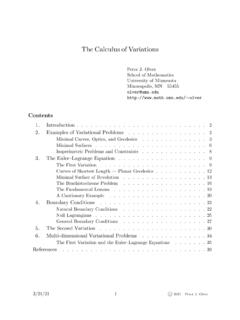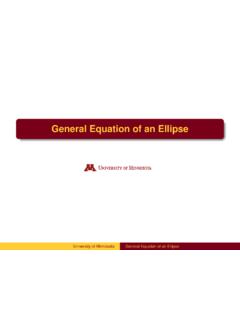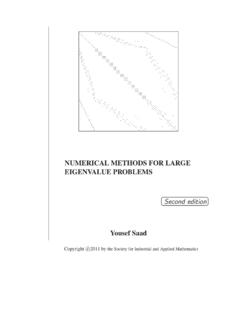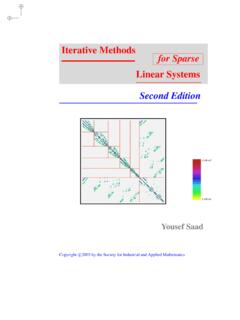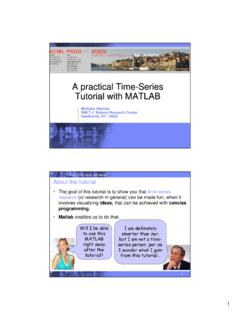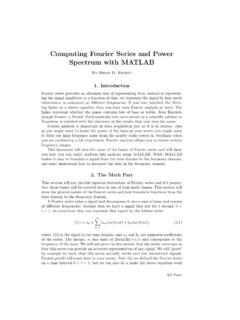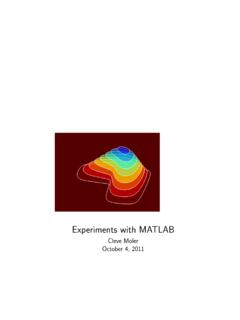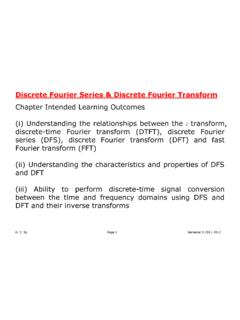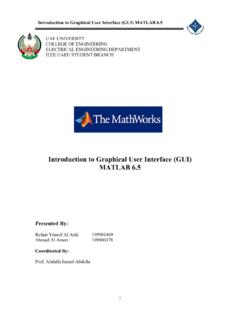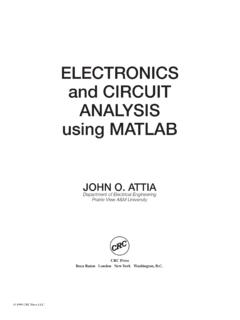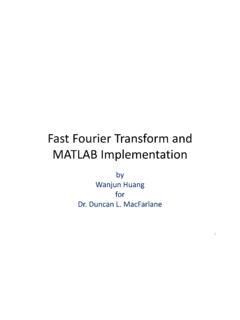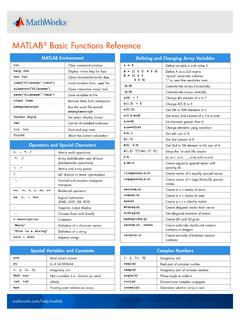Transcription of Chapter 1 The Fourier Transform - University of Minnesota
1 Chapter 1 The Fourier Fourier transforms as integralsThere are several ways to define the Fourier Transform of a functionf:R C. In this section, we define it using an integral representation and statesome basic uniqueness and inversion properties, without proof. Thereafter,we will consider the Transform as being defined as a suitable limit of Fourierseries, and will prove the results stated 1 Letf:R R. The Fourier Transform off L1(R), denotedbyF[f](.), is given by the integral:F[f](x) :=1 2 f(t) exp( ixt)dtforx Rfor which the integral exists. We have theDirichlet conditionfor inversion of Fourier 1 Letf:R R. Suppose that (1) |f|dtconverges and (2)in any finite interval,f,f are piecewise continuous with at most finitely manymaxima/minima/discontinuities.
2 LetF=F[f]. Then iffis continuous att R, we havef(t) =1 2 F(x) exp(itx)dx. This definition also makes sense for complex valuedfbut we stick here to real valuedf1 Moreover, iffis discontinuous att Randf(t+ 0)andf(t 0)denote theright and left limits offatt, then12[f(t+ 0) +f(t 0)] =1 2 F(x) exp(itx) the above, we deduce a uniqueness result:Theorem 2 Letf,g:R Rbe continuous,f ,g piecewise continuous. IfF[f](x) =F[g](x), xthenf(t) =g(t), : We have from inversion, easily thatf(t) =1 2 F[f](x) exp(itx)dx=1 2 F[g](x) exp(itx)dx=g(t).2 Example 1 Find the Fourier Transform off(t) = exp( |t|)and hence usinginversion, deduce that 0dx1+x2= 2and 0xsin(xt)1+x2dx= exp( t)2, t > writeF(x) =1 2 f(t) exp( ixt)dt=1 2 [ 0 exp(t(1 ix))dt+ 0exp( t(1 +ix))]= 2 11 + by the inversion formula,exp( |t|) =1 2 F(x) exp(ixt)dx=1 [ 0exp(ixt) + exp( ixt)1 +x2dt]=2 0cos(xt)1 + this formula holds att= 0, so substitutingt= 0 into the above givesthe first required identity.
3 Differentiating with respect totas we may fort >0, gives the second required in a similar way as the above example, we can easily showthatF[exp( 12t2)](x) = exp( 12x2), x will discuss this example in more detail later in this will also show that we can reinterpret Definition 1 to obtain theFourier Transform of any complex valuedf L2(R), and that the Fouriertransform is unitary on this space:Theorem 3 Iff,g L2(R)thenF[f],F[g] L2(R)and f(t)g(t)dt= F[f](x)F[g](x) is a result of fundamental importance for applications in signal The Transform as a limit of Fourier seriesWe start by constructing the Fourier series (complex form) for functions onan interval [ L, L]. The ON basis functions areen(t) =1 2 LeintL, n= 0, 1, ,and a sufficiently smooth functionfof period 2 Lcan be expanded asf(t) = n= (12 L L Lf(x)e inxLdx) purposes of motivation let us abandon periodicity and think of the func-tionsfas differentiable everywhere, vanishing att= Land identicallyzero outside [ L, L].
4 We rewrite this asf(t) = n= eintL12 L f(nL)which looks like a Riemann sum approximation to the integralf(t) =12 f( )ei td ( )3to which it would converge asL . (Indeed, we are partitioning the interval [ L,L] into 2 Lsubintervals, each with partition width 1/L.) Here, f( ) = f(t)e i tdt.( )Similarly the Parseval formula forfon [ L, L], L L|f(t)|2dt= n= 12 L| f(nL)|2goes in the limit asL to thePlancherel identity2 |f(t)|2dt= | f( )|2d .( )Expression ( ) is called theFourier integralorFourier ( ) is called theinverse Fourier integralforf. The Plancherelidentity suggests that the Fourier Transform is a one-to-one norm preservingmap of the Hilbert spaceL2[ , ] onto itself (or to another copy of it-self).
5 We shall show that this is the case. Furthermore we shall show thatthe pointwise convergence properties of the inverse Fourier Transform aresomewhat similar to those of the Fourier series . Although we could makea rigorous justification of the the steps in the Riemann sum approximationabove, we will follow a different course and treat the convergence in the meanand pointwise convergence issues second notation that we shall use isF[f]( ) =1 2 f(t)e i tdt=1 2 f( )( )F [g](t) =1 2 g( )ei td ( )Note that, formally,F [ f](t) = 2 f(t). The first notation is used moreoften in the engineering literature. The second notation makes clear thatFandF are linear operators mappingL2[ , ] onto itself in one view, andFmapping thesignal spaceonto thefrequency spacewithF mapping thefrequency space onto the signal space in the other view.
6 In this notation thePlancherel theorem takes the more symmetric form |f(t)|2dt= |F[f]( )|2d .Examples:41. The box function (or rectangular wave) (t) = 1 if < t < 12ift= 0otherwise.( )Then, since (t) is an even function ande i t= cos( t) +isin( t), wehave ( ) = 2 F[ ]( ) = (t)e i tdt= (t) cos( t)dt= cos( t)dt=2 sin( ) = 2 sinc .Thus sinc is the Fourier Transform of the box function. The inverseFourier Transform is sinc( )ei td = (t),( )as follows from (??). Furthermore, we have | (t)|2dt= 2 and |sinc ( )|2d = 1from (??), so the Plancherel equality is verified in this case. Notethat the inverse Fourier Transform converged to the midpoint of thediscontinuity, just as for Fourier A truncated cosine (t) = cos 3tif < t < 12ift= , since the cosine is an even function, we have f( ) = 2 F[f]( ) = f(t)e i tdt= cos(3t) cos( t)dt=2 sin( )9 A truncated sine (t) ={sin 3tif t the sine is an odd function, we have f( ) = 2 F[f]( ) = f(t)e i tdt= i sin(3t) sin( t)dt= 6isin( )9 A triangular (t) = 1 +tif 1 t 0 1if 0 t 10otherwise.}
7 ( )Then, sincefis an even function, we have f( ) = 2 F[f]( ) = f(t)e i tdt= 2 10(1 t) cos( t)dt=2 2 cos : The Fourier transforms of the discontinuous functions above decayas1 for| | whereas the Fourier transforms of the continuous functionsdecay as1 2. The coefficients in the Fourier series of the analogous functionsdecay as1n,1n2, respectively, as|n| . of the Fourier transformRecall thatF[f]( ) =1 2 f(t)e i tdt=1 2 f( )F [g](t) =1 2 g( )ei td We list some properties of the Fourier Transform that will enable us to build arepertoire of transforms from a few basic examples. Suppose thatf,gbelongtoL1[ , ], , |f(t)|dt < with a similar statement forg. We canstate the following (whose straightforward proofs are left to the reader) are linear operators.
8 Fora,b Cwe haveF[af+bg] =aF[f] +bF[g],F [af+bg] =aF [f] +bF [g].2. Supposetnf(t) L1[ , ] for some positive integern. ThenF[tnf(t)]( ) =indnd n{F[f]( )}.3. Suppose nf( ) L1[ , ] for some positive integern. ThenF [ nf( )](t) =indndtn{F [f](t)}.4. Suppose thenth derivativef(n)(t) L1[ , ] and piecewise contin-uous for some positive integern, andfand the lower derivatives areall continuous in ( , ). ThenF[f(n)]( ) = (i )nF[f]( )}.5. Supposenth derivativef(n)( ) L1[ , ] for some positive integernand piecewise continuous for some positive integern, andfand thelower derivatives are all continuous in ( , ). ThenF [f(n)](t) = ( it)nF [f](t).6. The Fourier Transform of a translation by real numberais given byF[f(t a)]( ) =e i aF[f]( ).
9 7. The Fourier Transform of a scaling by positive numberbis given byF[f(bt)]( ) =1bF[f]( b).8. The Fourier Transform of a translated and scaled function is given byF[f(bt a)]( ) =1be i a/bF[f]( b).Examples7 We want to compute the Fourier Transform of the rectangular box func-tion with support on [c,d]:R(t) = 1 ifc < t < d12ift=c, that the box function (t) = 1 if < t < 12ift= the Fourier Transform ( ) = 2 sinc . but we can obtainRfrom by first translatingt s=t (c+d)2and then rescalings 2 d cs:R(t) = (2 d ct c+dd c). R( ) =4 2d cei (c+d)/(d c)sinc(2 d c).( )Furthermore, from (??) we can check that the inverse Fourier transformof RisR, ,F (F)R(t) =R(t). Consider the truncated sine wavef(t) ={sin 3tif t 0otherwisewith f( ) = 6isin( )9 that the derivativef off(t) is just 3g(t) (except at 2 points)whereg(t) is the truncated cosine waveg(t) = cos 3tif < t < 12ift= have computed g( ) =2 sin( )9 3 g( ) = (i ) f( ), as predicted.}
10 Reversing the example above we can differentiate the truncated cosinewave to get the truncated sine wave. The prediction for the Fouriertransform doesn t work! Why not? Fourier Transform of a convolutionThe following property of the Fourier Transform is of particular importancein signal processing. Supposef,gbelong toL1[ , ].Definition 2 The convolution offandgis the functionf gdefined by(f g)(t) = f(t x)g(x) also that (f g)(t) = f(x)g(t x)dx, as can be shown by a changeof 1f g L1[ , ]and |f g(t)|dt= |f(x)|dx |g(t)| of proof: |f g(t)|dt= ( |f(x)g(t x)|dx)dt= ( |g(t x)|dt)|f(x)|dx= |g(t)|dt |f(x)| 4 Leth=f g. Then h( ) = f( ) g( ).Sketch of proof: h( ) = f g(t)e i tdt= ( f(x)g(t x)dx)e i tdt= f(x)e i x( g(t x)e i (t x)dt)dx= f(x)e i xdx g( )= f( ) g( ).
